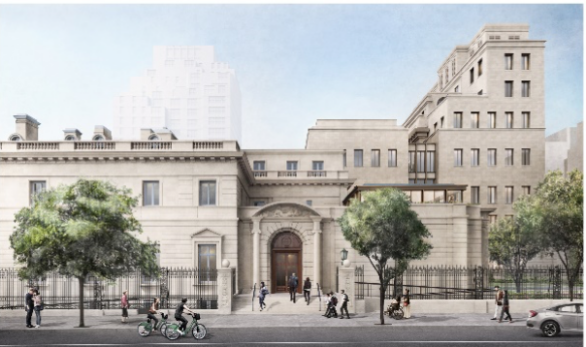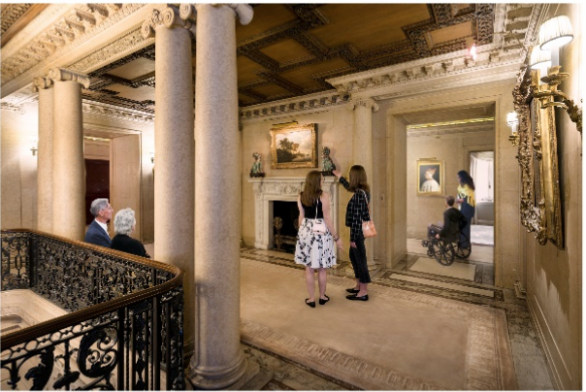The Frick Collection Reveals Plans for New Collection Galleries
on Second Floor of Original Residence
~~~~~~~~~~~~~~~~~~~~~~~~~~~~~~

The Frick Collection from 70th Street; courtesy of Selldorf Architects.
Frick to Reopen in Renovated Fifth Avenue Home in Late 2024
~~~~~~~~~~~~~~~~~~~~~~~~~~~~~~~
New York (March 28, 2024) — The Frick Collection announced details about the transformation of the second floor of the original Frick residence, which will become accessible to the public for the first time when the institution reopens in its renovated and expanded home in late 2024. Designed by Selldorf Architects, with Beyer Blinder Belle serving as Executive Architect, the project marks the most comprehensive upgrade to the Frick since opening nearly ninety years ago. The mansion’s second floor originally served as the private living quarters of the Frick family and subsequently became the institution’s administrative offices after the residence was converted to a museum in 1935.
The restoration of a suite of ten rooms and their transition into galleries will, for the first time, enable the public to experience more of the Frick’s historic buildings and remarkable collection, which has expanded significantly over the decades.
A highlight of the second floor will be the rare opportunity to experience two rooms as they were installed when the Frick family lived in the mansion. This includes a new gallery in what was the Frick family’s Breakfast Room and the Boucher Room, which is being returned to its original upstairs location in the private sitting room—or boudoir—of Adelaide Childs Frick, the wife of founder Henry Clay Frick. In a further series of second-floor galleries, visitors will experience installations inspired by the personal collecting interests of the Frick family through time, including beloved Renaissance gold-ground and Impressionist paintings. Also on view will be significant collections that have more recently entered into the museum’s holdings—some of which have yet to be regularly exhibited—ranging from ceramics to rare portrait medals and including the first permanent display of the Frick’s important clocks and watches collection.
————————————
Stated Ian Wardropper, the Frick’s Anna-Maria and Stephen Kellen Director, “Our renovation and enhancement project seamlessly integrates the old and new, while preserving the intimate visitor experience of the Frick’s art and architecture. With the opening of the mansion’s historic second floor, we will be able to showcase significantly more of our unparalleled collections, which have expanded in strategic and significant ways over the years through acquisitions and a number of individual and collection gifts. We cannot wait to welcome the public back to our revitalized home, where they can revisit beloved spaces and discover new aspects of our history, collection, and buildings.”
————————————
“The reopening of the Frick marks the first time in the museum’s history that the public will be able to access—via the grand staircase and new elevators—the historic mansion’s second floor,” said Xavier F. Salomon, the Frick’s Deputy Director and Peter Jay Sharp Chief Curator. “While in the grand galleries of the first floor, we will continue to present larger works, such as our remarkable panel by Bellini, full-length portraits by Gainsborough and Van Dyck, and monumental canvases by Fragonard, Veronese, and Whistler, we will now have the ability to spotlight artworks and objects of a more intimate scale in focused presentations in new second-floor rooms.”
————————————

The second-floor landing, which leads to a series of new galleries for the display of small-scale objects
from the permanent collection; courtesy of Selldorf Architects.
————————————
NEW GALLERIES
ON THE HISTORIC MANSION’S SECOND FLOOR
~~~~~~~~~~~~~~~~~~~~~~~~~~~~~~~
Complementing the grand galleries of the Frick’s first floor, which include the Oval Room, East and West Galleries, Fragonard Room, Dining Room, and Living Hall, the second-floor galleries will provide entirely new opportunities for visitors to engage with the Frick’s holdings and historic spaces. Careful restoration and preservation of architectural and decorative features—including ceiling murals, marble fireplaces, and elaborate carved woodwork—are bringing the intimate rooms of the former residence back to life, with varied arrangements of smaller-scale paintings, sculptures, and decorative objects from different schools and periods. Most art displays on this floor will preserve the traditional blend of objects for which the Frick is known, with select galleries centered on one period or medium.
Two of the new spaces are being restored to their appearance from when the Frick family resided in the house: the Breakfast Room and the Boucher Room. The Breakfast Room—ideally situated for morning light with its east-facing windows—has been reinstated as the family had decorated it, presenting the museum’s treasured holdings from the French Barbizon school of landscape painting, including works by Corot, Rousseau, and Daubigny.
Visitors will also experience the original Boucher Room, which adorned the boudoir of Adelaide Childs Frick (1859–1931). When, after several years of transformation, the residence opened as a museum in 1935, the eight panels by Boucher depicting the Arts and Sciences were moved to the ground floor to make them accessible to the public. The second-floor room is now being carefully returned to its appearance from when Adelaide Frick was alive. The series of paintings will be presented in a full suite of restored wall paneling, complemented by a series of other works and details from the same period: a marble chimneypiece; delicate Sèvres porcelain; important French furniture that has been treated and reupholstered; and the eighteenth-century wood flooring that originally graced this Gilded Age boudoir. All of these elements have been painstakingly disassembled, treated, and relocated upstairs to complete the gallery’s setting.
Further rooms will pay tribute to the individual collecting interests of the Frick family members. The original bedroom of Henry Clay Frick (1849–1919), which has become known at the museum as the Walnut Room for its sumptuous wood paneling, will present a selection of portraits, one of the founder’s favored genres. Highlights include Romney’s famed 1782 portrayal of Lady Hamilton, which once again will hold pride of place over the room’s mantelpiece, as well as Ingres’s exquisite Comtesse d’Haussonville (1845), one of the most iconic paintings in the Frick’s holdings. Another thematic gallery will feature Impressionist paintings, which were considered modern art during Frick’s lifetime and which Frick chose to display in the family’s private quarters.
Other rooms pay tribute to the significant role that the founder’s daughter Helen Clay Frick (1888–1984) played in shaping the collection during her father’s lifetime and for decades after his death. This includes an installation of early Italian Renaissance paintings, a particular passion of hers—including prized works by Cimabue, Piero della Francesca, and Paolo Veneziano—presented in Helen’s former bedroom.
Additional galleries and spaces on this floor will afford visitors the chance to look closely at exceptional holdings that have come to the Frick as major gifts. The Frick’s collections have grown in a focused and complementary manner over the decades, with more than half of the institution’s holdings coming from acquisitions after the original bequest of Henry Clay Frick. Many of these collections have been shown only in part or temporarily because of space constraints. These new gallery installations include a presentation of French faience ceramics, the bequest of Sidney R. Knafel; remarkable works of Viennese Du Paquier porcelain given by Melinda and Paul Sullivan; and a special display of rare portrait medals from the unparalleled holdings of Stephen K. and Janie Woo Scher.
The installation of the Frick’s second floor has been designed by the curatorial team led by Deputy Director and Peter Jay Sharp Chief Curator Xavier F. Salomon with Curator Aimee Ng, Assistant Curator of Sculpture Giulio Dalvit, and Assistant Curator of Decorative Arts Marie-Laure Buku Pongo, in association with the Frick’s longtime exhibition designer, Stephen Saitas.
————————————

frick.org
~~~~~~~~~~~~~~~~~~~~~~~~~~~~~~
Visit: AAQ / Museum Architecture:
The Frick Collection — Expansion & Enhancement / Selldorf Architects / Groundbreaking 2020 — link
————————————-
========================================================

AAQ / Resource: Riverhead Toyota
________________________________________________________
